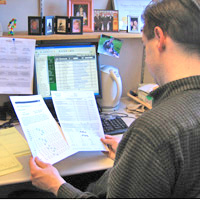Faculty Facing Low Student Ratings

Synopsis:
Dr. Gregory Plyczech has created a new course in Aerospace Engineering. His end-of-term student evaluations, however, were lower than expected. Concerned about the effect of low ratings on his tenure plans, he reviewed his student ratings with an instructional consultant.
Dr. Gregory Plyczech has created a new course in Aerospace Engineering. His end-of-term student evaluations, however, were lower than expected. Concerned about the effect of low ratings on his tenure plans, he reviewed his student ratings with an instructional consultant.
Full Story:
Dr. Plyczech, an Associate Professor of Aerospace Engineering at a large university, created a course last year on systems engineering for space missions and has only taught it once, last semester. He spent a good deal of time before the term preparing all of the course materials, including the syllabus, reading lists, lectures, and handouts. He also assigned individual writing reports and group project.
Dr. Plyczech, an Associate Professor of Aerospace Engineering at a large university, created a course last year on systems engineering for space missions and has only taught it once, last semester. He spent a good deal of time before the term preparing all of the course materials, including the syllabus, reading lists, lectures, and handouts. He also assigned individual writing reports and group project.
Strategies Menu
Despite this effort, his student evaluations from the first semester were much lower than he expected: 2.8 out of 5. How surprising since he felt that the class went pretty well for the first time teaching; he thought he had provided a unique and inclusive learning environment and made himself available for students' questions.
In reading the students' written comments he noted that many students complained about the frustrations of working in groups. Others were frustrated by the sheer magnitude of the projects. Some students claimed they didn't learn much from the lectures though they appeared to learn from the projects.
Fearful of how low student ratings would impact his tenure case, Gregory addressed his disappointing evaluations with an instructional consultant. The instructional consultant and Dr. Plyczech discussed some ways to learn and make improvements from these ratings.
- Students' comments on the ratings can be ambiguous. Focus on identifying the key problems in class. Try looking at all of the comments for one question to identify patterns. Student ratings can be difficult to interpret for multiple reasons. One factor could be the diversity of student experience; some things may work well for some students but not for others, so the student comments may be contradictory. Also, comments may be emotionally laden. Distance yourself emotionally from the negative comments in order to objectively look for the improvements.
- Many students require instruction in the non-technical skills necessary for effective team work, such as listening, delegating work fairly, or managing conflict (often termed “soft skills”). Such instruction will help prepare students for the challenges that often arise in collaborative working groups, and thereby increase both student learning and student satisfaction.
- Course design is an iterative process. Even the best of instructors can't predict the ways the class will turn out; therefore, all instructors iterate the course design. Remind yourself that class won't be perfect the first time. It takes most faculty 3 or 4 iterations to be satisfied with their course.
- Use multiple classroom assessment techniques. Classroom assessment techniques give you data about your students' learning in an ungraded, non-threatening way. They are quick, like the Minute Paper, and help you identify problems and misunderstandings early in the term. In a new class like this, consider using an early course evaluation by having an instructional consultant or your department chair sit in one class session partially into the term and give you feedback. Getting a sense of your teaching at this time in the course allows you to make changes and to impact the course.
Gregory reviewed his students' comments in light of these issues and determined that the key problem was that students struggled with the group project, e.g., agreeing with teammates, fair workload across team members, and the excessive time commitment. The next time he taught the systems engineering class he offered tips for working in a team, and he changed the project's grading so that team members could rate each person's level of participation.
